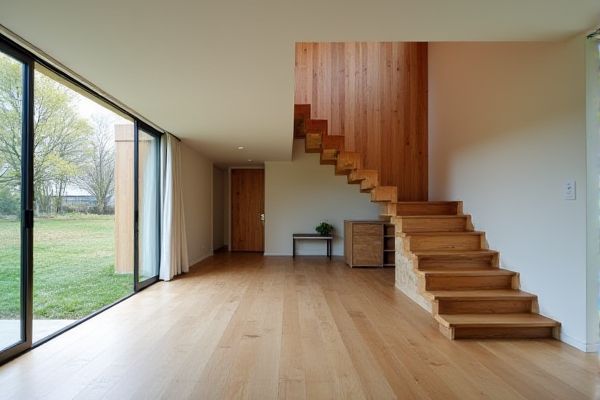
Open spine staircases feature a minimalistic design with visible gaps between the treads, creating a lighter, airier appearance that enhances natural light flow and modern aesthetics. Solid spine staircases provide a robust, continuous central support offering greater structural stability and a more traditional, substantial look; explore the rest of the article to understand which option best suits your space and style preferences.
Table of Comparison
| Feature | Open Spine Staircase | Solid Spine Staircase |
|---|---|---|
| Structure | Central open steel or wooden spine supporting treads | Central solid beam or stringer fully supporting treads |
| Visual Appeal | Modern, airy, and lightweight look | Sturdier, traditional, and more substantial appearance |
| Installation | Complex due to balancing and alignment | Relatively straightforward and robust |
| Cost | Higher due to design and materials | Moderate to lower cost |
| Load Capacity | Supports less weight; engineered for measured loads | Higher load-bearing capacity |
| Maintenance | Requires frequent checks for tension and stability | Less maintenance, durable structure |
| Safety | Open design may need additional railing for safety | Enclosed, inherently safer |
Overview of Staircase Spine Designs
Open spine staircases feature a central stringer with visible gaps, creating a light, airy aesthetic that enhances spatial perception and modern interiors. Solid spine staircases consist of a continuous central beam, offering robust structural support and a more traditional, enclosed look suitable for heavy usage. Understanding these spine designs helps you select the optimal balance between visual appeal and functional strength for your staircase project.
What Is an Open Spine Staircase?
An open spine staircase features a central structural beam or spine that supports the treads without enclosed risers, creating a visually lightweight and airy design. Unlike solid spine staircases, which have a fully enclosed central support, open spine staircases emphasize openness and transparency, often utilizing minimalistic metal or timber elements for the spine. This design not only enhances aesthetic appeal but also allows more natural light to pass through, making spaces feel larger and more connected.
What Is a Solid Spine Staircase?
A solid spine staircase features a central load-bearing beam, typically made of steel or wood, that supports the treads on either side. This design provides robust structural integrity and allows for a sleek, minimalist look with no visible supports underneath the steps. Unlike open spine staircases, which have separate stringers or open frameworks, solid spine staircases offer enhanced stability and a more solid, continuous appearance.
Aesthetic Differences: Open vs Solid Spine
Open spine staircases create a lighter, more transparent aesthetic by featuring gaps that allow light and views to pass through, enhancing the sense of space and modern elegance in your interior. Solid spine staircases offer a more substantial, robust appearance with a continuous central support, providing a bold architectural statement and a sense of solidity. Choosing between the two affects the visual openness and style impact of your staircase, which plays a crucial role in defining the overall atmosphere of your living space.
Structural Strength and Durability
Open spine staircases offer a modern aesthetic with visible support beams, but solid spine staircases provide superior structural strength and durability due to their continuous, robust central support. The solid spine design efficiently distributes loads and resists lateral forces, ensuring long-term stability in high-traffic areas. Your choice should consider the balance between the desired visual appeal of an open spine and the enhanced strength provided by a solid spine staircase.
Space Efficiency and Visual Impact
Open spine staircases maximize space efficiency by minimizing the material between steps, creating a lighter, more transparent structure that visually expands room dimensions. Solid spine staircases feature a continuous central support, providing a robust, sculptural element that occupies more space but can serve as a striking architectural focal point. The choice between open and solid spine designs significantly influences spatial perception and openness in interior environments.
Safety Considerations and Building Codes
Open spine staircases require careful attention to safety features such as handrail height, baluster spacing, and load-bearing capacity to comply with building codes, ensuring structural stability and preventing falls. Solid spine staircases inherently offer enhanced rigidity and support, often making it easier to meet stringent safety standards, especially in commercial or high-traffic environments. Building codes typically mandate specific dimensions, material strengths, and guardrail requirements for both types to ensure occupant safety and prevent accidents.
Material Options for Open and Solid Spines
Open spine staircases often utilize steel or timber for their framework, allowing a modern, airy design that can incorporate glass or metal balustrades to complement the open aesthetic. Solid spine staircases typically use robust materials such as concrete, timber, or steel to create a continuous central support that provides a more traditional and sturdy appearance. Your choice between open and solid spines will influence material selection based on desired visual impact, structural requirements, and interior design style.
Installation and Maintenance Factors
Open spine staircases offer easier installation due to their modular design and fewer structural components, allowing quicker assembly and adjustment on site. Solid spine staircases require more precise alignment and heavier lifting, resulting in longer installation times and the potential need for specialized tools or professionals. Maintenance for open spine stairs is simplified with accessible parts for cleaning and repairs, whereas solid spine designs can be more challenging to maintain due to enclosed structural elements that may trap dust and require more effort to inspect.
Cost Comparison and Budget Implications
Open spine staircases typically cost more than solid spine staircases due to their intricate design and the need for specialized materials and labor. Solid spine staircases offer a more budget-friendly option, with simpler construction reducing both material expenses and installation time. When planning your project, choosing a solid spine staircase can help maintain cost efficiency without compromising structural integrity.
 homyna.com
homyna.com